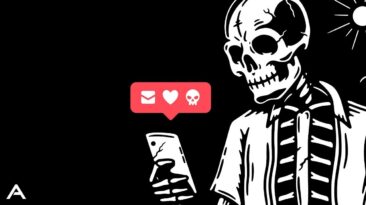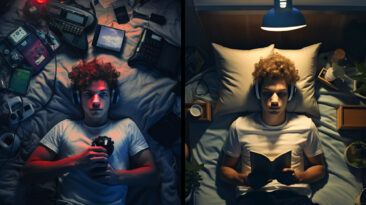If you’re watching this right now, chances are you spent many years of your life feeling misunderstood. Maybe you coped by spending hours online or listening to pop punk alone in your bedroom. You might have wished to run away or for a simple answer that would sort out all the mixed-up feelings in your head.
A young person’s life is never easy. Many teens suffer from severe anxiety, depression and suicidal ideation. Compounded by school stress, relationship drama and family pressures, mental illness during youth is intense. Thousands of young people die by suicide each year.
But many more teens do not suffer from mental illness. Sure, managing school, interpersonal relationships and growing responsibilities is challenging. But learning to deal with these struggles and becoming resilient is a part of life. So why is it that when you scroll on TikTok or Twitter, teens seem so, well, sad?
It’s not just the teens. People of all ages repost memes making fun of depression or TikToks of what they ate while suffering from an eating disorder. There are highly aestheticized accounts of suffering, whether earnest or ironic. Some of them make us laugh, while others inspire us to sort of want these things.
What’s going on here? No one ever sees physical illness and thinks, “I want that for myself.” So why’s it different with mental illness? The reality is that your perception of mental health warps how you view your own. And if it’s culturally acceptable to joke about or aestheticize mental illness, it might become an alluring, sexy or desirable condition to have.
Do you ever fantasize about being mentally ill despite having no formal diagnosis? It might seem dark to admit it to yourself, but the truth is that you could be romanticizing mental illness without even knowing it.
Let me be clear that the reality is mental illness ruins lives. It is messy and complicated; it strains families, makes it challenging to work and is way more complex than a meme or TikTok can portray.
So why is it so alluring to flirt with the aesthetics of mental illness?
970 million people around the world suffer from a mental illness. That’s 1 in 8 people, and the figures are rising. All of these people will tell you that it’s nothing to be romanticized about. It causes pain and hurt and can be very difficult to manage.
It has something to do with finding beauty in suffering. I was particularly drawn to Tumblr posts in my youth because they depicted an idealized version of a dire circumstance. They let me see the pain in the world through rose-colored lenses.
And it’s not just social media. It’s in film and television as well. Stories that depict mentally ill characters help us reimagine and work through our mental health struggles. Films like Girl, Interrupted, Silver Linings Playbook and Fight Club show stories of what it’s like living with mental illness and how it affects relationships with family and friends.
To someone going through similar struggles, it might be relatable to see parts of your story represented on screen. For others, stories about mental health might offer you a new perspective, start a productive conversation or open a channel for empathy.
The problem, though, is that aesthetics will always be at the forefront of how we connect to art. Angelina Jolie and Jennifer Lawrence are stunning Hollywood actresses. Tyler Durden of Fight Club represents a male ideal that some may strive for.
This is how the media makes us romanticize mental illness by making it more attractive and desirable than it is. When you glorify mental illness, you convince yourself to believe a situation is better than it is in reality.
Think about the lives of some of the world’s most famous artists. Marilyn Monroe was a beautiful movie star and one of the greatest actresses of all time. Her struggles with eating disorders, pill addiction and depression are a part of her tragically glamorous story. Culturally, her mental illnesses are linked to her iconic status. In public memory, her beauty and her pain are intertwined. As a result, all parts of her life are romanticized, even the less romantic elements.
What about Kurt Cobain, the lead singer of the 90s grunge band Nirvana? His music gave voice to a generation as he made art about what it was like living with depression and addiction. His death by suicide in 1994 solidified his icon status in the music world. His death is part of his legacy as an artist, and how he died provides a lens through which we look at the art he made while he was alive. We see his genius as inseparable from his mental illness.
Vincent Van Gogh follows a similar pattern. He spent most of his life painting in obscurity, out of the public eye. Only after his death did the public learn about his mental illness and start associating that with his creativity.
Whether it’s drunken nights in Paris or the infamous cutting off of his ear, the public’s understanding of masterpieces such as Starry Night and Sunflowers is tied to Van Gogh’s mental health struggles. It endears people to his story and transforms him into a tragic genius.
The intersection of mental illness and art is a prime example of romanticization. We look up to and admire artists who create work we love. We assume their mental illnesses offer them clairvoyance and the unique ability to create magnificent art.
That’s why many young artists believe they must suffer to be like the greats. Who subconsciously wish mental illnesses upon themselves in hopes that it would help them create better art.
Today, it’s no longer just artists creating masterpieces that paint a pretty picture of mental illness. It’s everyone who has a camera and an internet connection.
There’s a phenomenon called ‘thinspo,’ where people suffering from eating disorders post pictures of their starved bodies online along with diets to inspire others to achieve a similar look. In the same vein, people post aestheticized pictures of self-mutilation in an attempt to encourage others to do the same.
All you have to do is scroll through any social media platform to find countless seemingly harmless memes about wanting to die to recognize that deteriorating mental health is a popular topic of conversation among people.
Before the internet, these feelings had no outlet to be aired publicly. They only happened alone or among small groups of friends, if at all. Now, not only do they have an outlet, but they have the distribution to reach millions of people in an instant.
It begs the question, is the online discourse surrounding mental health productive? Or is it distorting the reality of those who struggle daily?
The truth is the romanticization of mental illness is not black or white. It can be destructive, yes. But it also has its benefits.
It seems contradictory to reframe suffering and mental anguish as desirable. It sounds more logical to want a happy life, free of anything that could get in the way of ultimate contentment. Why would you like to invite suffering? Isn’t it something you would want to cast away?
That makes total sense on paper, but the reality is that suffering is a part of life, whether we want it or not. Spinning it as something noble, exciting or cool can genuinely help people get through the issues.
This is what romanticization helps with. You convince yourself that you are mysterious, edgy or aloof instead of socially anxious or depressed. Instead of feeling like an outcast, you become a rebel, championing the fight against the status quo. You take your pain and turn it into an identity that gives you social credibility.
Romanticization allows your situation to feel acceptable, loved, and even coveted by mainstream society. You can regain a sense of control and power when you feel powerless. When you romanticize, the narrative of your life is in your hands. You can frame your suffering however you please.
In a moderate and controlled environment, I don’t see a massive problem with some light romanticization of mental illness. Even when life feels the worst, there can still be funny, enjoyable and beautiful moments. Finding joy in those moments amid your struggle or trying to see your situation through a different perspective can help you get through it.
There has been a positive push toward de-stigmatizing mental illness in recent years. As a culture, we are trying to eradicate the shame historically associated with mental health. People are more willing to honestly discuss their struggles and receive treatment when necessary.
While this is a positive step forward, the conversation about mental health has become too ordinary in some ways.
It’s essential to have open and honest conversations about mental illness. But if, by definition, romanticism misrepresents mental illness, how is honesty possible? Can true healing happen in a society with a romantic outlook on mental illness?
The worst thing about romanticization is when it’s done by people who are not mentally ill but wish to be. Those who take on the aesthetic of mental illness without understanding the real pain it causes people.
Some people make a particular condition the cornerstone of their content and turn symptoms into fun little quirks that their young fans might start to mimic without knowing how damaging it can be in the long run.
Content posted by teenagers in their bedrooms now serves a similar function to the representation on TV and in movies. Only now, viewers can access it on their phone while in bed, waiting for the bus or during downtime in class. The problem is that consuming too much mental health-oriented content can lead to self-diagnosing or identifying with a mental illness you do not clinically have.
It’s a form of mimetic desire, which are desires we mimic from the people or culture around us. People might feel an average amount of sadness and think they’re depressed. Mood swings are explained by bipolar disorder. Neatness and particularness turn into OCD. Difficulty focusing on a specific task becomes an ADHD diagnosis.
The genuinely undesirable symptoms are often left out of these fantasies. With severe depression comes suicidal ideation. Bipolar disorder makes it challenging to have a steady job or healthy relationships. Some people with OCD find it hard to leave the house and struggle with crippling anxiety. The reality of ADHD is not fun or cute; it often leaves people feeling overwhelmed and overstimulated by even the smallest daily tasks.
Think about the countless hours spent in therapy, the prescription drugs and sometimes hospitalizations some people endure to manage their mental illness. When we romanticize mental illness, we undermine the seriousness of certain mental conditions.
The public has become very familiar with mental health vocabulary and symptoms, which, on the one hand, helps with early diagnosis and encourages people to seek help. But on the other hand, this familiarity has given everyone a false sense of authority about the topic. People start to diagnose not just themselves but their followers.
Labeling and categorizing human behavior might explain why you act the way you do. And that’s satisfying. It takes away the mystery behind your quirks or life struggles. But when that is not done under the supervision of a healthcare provider, it can lead to serious issues.
We’ve learned not to Google our symptoms when we have physical health issues. So why do we do the same when we have mental health issues?
Look at the online discourse and see how blurred the line between mental health and mental illness is. Like physical health, mental health is something everyone must maintain. But just because you struggle with your mental health doesn’t mean you are mentally ill. Conflating the two minimizes the suffering someone with a diagnosed mental illness has to go through daily.
Romanticizing mental illness is a misrepresentation of the whole story. It’s best to maintain a neutral stance when engaging with this topic. Try being the keyword here. Because the truth is mental illness will always be complicated and messy. It changes human behavior, and productive conversations do not compartmentalize neatly, which is why, to an extent, romanticization might be inevitable. It’s human nature to spin a situation to be more desirable or attractive.
Knowing this, how do we reset our mindset when influenced to maintain a neutral stand when discussing mental health?
First, you must give yourself a reality check on what mental illness means and how it affects people. It’s not languishing delicately in a chaise lounge or manically cleaning the house. It’s ugly, gritty and gets in the way of relationships. It’s not cute, quirky, or fun. It destroys lives.
Remind yourself that it’s unethical to appropriate the aesthetics of mental illness for this reason. Wearing the mask without understanding the pain hidden beneath it.
Recognize that most aspects of people’s mental health journey remain private. Behind closed doors, you don’t know people’s struggles, so it’s crucial to delve into the nuances and complexities of dealing with mental illnesses and steer clear of an overly romantic outlook.
Then, and only then, can you flirt with romanticism occasionally instead of using it as a lens through which to interpret mental illness as a whole.



















